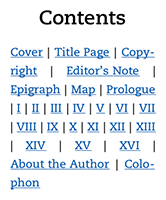
The order for front matter and back matter for print has been covered earlier.
I’ve modified the order slightly for e-books to make them more reader-friendly.
Note that I build the EPUBs myself. Chapters and sections listed below are in separate files.
Front matter
- Cover
- Title page (may be combined with copyright page OR may include a brief description to nudge the memories of readers who may have downloaded the book months ago)
- Copyright page (with dedication or epigraph at top, if author permits; includes linked publisher contact info)
- Dedication (if author wants it on separate page)
- Epigraph (may be combined with copyright page if no dedication)
- Contents (if no titles, chapter #s are in a single paragraph separated by | or extra space); required at front by Amazon[1]
- Foreword (written by someone other than the author)
- Preface (written by author; may include acknowledgments)
Text
- Prologue
- Chapters
- Epilogue
Back matter
- Acknowledgments
- Appendix
- Notes
- Glossary
- References
- Index (if author budget allows linking; otherwise removed)
- About the author (includes links to promo mat’l, if not elsewhere)
- Other books by author (links to promo mat’l)
My preferences
 As a reader, I prefer a combined title page/copyright page at the front over moving the copyright to the back, which does comply with U.S requirements[2] but annoys readers like me who enjoy reading the copyright page.
As a reader, I prefer a combined title page/copyright page at the front over moving the copyright to the back, which does comply with U.S requirements[2] but annoys readers like me who enjoy reading the copyright page.
If you combine the title page and copyright page, please leave some space below the last line of title page stuff. If you combine the title page and copyright page, then the dedication on the copyright page looks funny to me.
The acknowledgments (where you thank your writing buddies and the coffee shop down the street and the homicide detective who gave you tips about blood spatter patterns and your parents, Ayn Rand and God) can go at the end, right after the last chapter. They’re frequently at the end in print books also.
I like to put the dedication at the top of the copyright page followed by some white space. If you look at mass market paperbacks, they often put the dedication at the top of the copyright page. Some authors prefer a separate page for the ebook dedication.
A dedication and acknowledgments are both optional, by the way.
The title page traditionally includes book title, book subtitle, series title, author name, publisher name, and publisher city (not contact info). The publisher state or country is omitted unless it’s a little-known city like Mudburg. If the title and subtitle are on one line, separate them with a colon. If they’re on separate lines, just make the title a little bigger or bold, or make the subtitle a little smaller or not bold.
Note 1: Here’s what the Amazon Kindle Publishing Guidelines say:
3.3.6 TOC Guideline #6: Place the TOC at the Front of the Book
Place the HTML TOC towards the beginning of the book and not at the end of the book.
Note 2: Regarding the placement of the copyright notice, here’s what the U.S. Copyright Office says:
Code of Federal Regulation, Title 37: Patents, Trademarks, and Copyrights
§201.20 Methods of affixation and positions of the copyright notice on various types of works.
(a) General. (1) This section specifies examples of methods of affixation and positions of the copyright notice on various types of works that will satisfy the notice requirement of section 401(c) of title 17 of the United States Code, as amended by Pub. L. 94-553. A notice considered “acceptable” under this regulation shall be considered to satisfy the requirement of that section that it be “affixed to the copies in such manner and location as to give reasonable notice of the claim of copyright.” As provided by that section, the examples specified in this regulation shall not be considered exhaustive of methods of affixation and positions giving reasonable notice of the claim of copyright.
[…]
(2) Where, in a particular case, a notice does not appear in one of the precise locations prescribed in this section but a person looking in one of those locations would be reasonably certain to find a notice in another somewhat different location, that notice will be acceptable under this section.(d) Works published in book form. In the case of works published in book form, a notice reproduced on the copies in any of the following positions is acceptable:
(1) The title page, if any;
(2) The page immediately following the title page, if any;
(3) Either side of the front cover, if any; or, if there is no front cover, either side of the front leaf of the copies;
(4) Either side of the back cover, if any; or, if there is no back cover, either side of the back leaf of the copies;
(5) The first page of the main body of the work;
(6) The last page of the main body of the work;
(7) Any page between the front page and the first page of the main body of the work, if:
(i) There are no more than ten pages between the front page and the first page of the main body of the work; and
(ii) The notice is reproduced prominently and is set apart from other matter on the page where it appears;
(8) Any page between the last page of the main body of the work and back page, if:
(i) There are no more than ten pages between the last page of the main body of the work and the back page; and
(ii) The notice is reproduced prominently and is set apart from the other matter on the page where it appears.